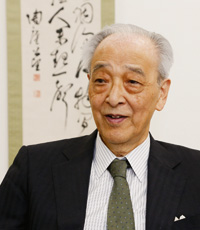How to Rebuke an Insolent Nation!
Wake Up, Land of the Samurai
It’s Time to Consolidate the US-Japan ‘Common Strategy to Contain China’
National Defense Strategy Founded on the principle of an ‘Invincible Land’
It is not necessary for the Japanese to feel guilty with regard to historic issues. However, that is not reason enough to rebuke China and South Korea in a dignified manner. What is needed is a national strategy founded on the principle of an ‘invincible land’ so that countermeasures can be taken against any unexpected move made by other countries. Let’s listen to the views of an expert on diplomacy and security.

Mr. Hisahiko Okazaki, former Ambassador to Thailand
Born in 1930 in Dalian. While reading law at Tokyo University, Mr. Okazaki passed the diplomatic service exam. He then joined the Ministry of Foreign Affairs. Mr. Okazaki earned a Bachelor of Economics degree from the University of Cambridge in 1995, and he also completed his Master’s degree coursework. In 1984, he became the first Director of the Information Research Bureau. Mr Okazaki served as Ambassador to Saudi Arabia and Thailand until his retirement in 1992. He is currently President and Director of the Okazaki Institute, an NPO. He has authored many books, including ‘Mutsu Munemitsu to sono jidai’ [Munemitsu Mutsu and his Era] (published by PHP Institute Office International, Inc.) and ‘Shin no hoshu to wa nanika?’ [What is True Conservatism?] (published by PHP Shinsho).
Mr. Munemitsu Mutsu’s Path to Victory Through Use of the Preemptive Strike
Since the fishing boat collision in September 2010*1, Japan has missed the opportunity to shore up its national defense. When US Secretary of State Clinton declared that the Senkaku Islands were within the scope of US-Japan security following that incident, Japan should have resolved the issue of its right to collective self-defense*2. The Japanese government should have strengthened the US-Japan alliance so that there would have been no room left for China to take advantage of the Senkaku issue. However, for a year and a half Japan did nothing. China saw this as playing to its advantage as it is superior in military terms. China is equipped with more 4th generation fighter jets and so on, so it began to act with aggression over the Senkaku issue.
In diplomacy, since it is important to act in advance of opponents in order to prevent their opportunities, it could be said that Japan didn’t respond to China quickly enough. In this regard, the decision by the then Japanese Foreign Minister Munemitsu Mutsu to send troops into the First Sino-Japanese War was a brilliant feat of agility.
Struggling to come up with a way to suppress the Donghak Peasant Revolution, the Korean government officially requested Qing support after the government decided that Qing troops were required to quell the uprising. As soon as Mr. Mutsu obtained information about the Korean request for the support of Qing troops, he consulted with his government over the dispatch of the Japanese army. Then Mr. Mutsu immediately decided his policy. At that time, it took one day to sail from China to Korea by boat compared to three days from Japan, so Mr. Mutsu’s prompt decision was significant in light of the course of the war and the subsequent fate of Japan.
Since President Nixon Governed America, There Has Been No US-Japan Strategy Against China
At this stage, what Japan should do is establish a US-Japan ‘common strategy to contain China’. Since the Nixon administration opened relations with China in the 1970’s, there has been no common US-Japan strategy to contain China.
A main pillar of this plan must be the right to collective self-defense. In addition, the Futenma issue*3 must be resolved. Likewise, a consensus should be established whereby America makes no complaint if Japan strengthens its effective control over the Senkaku islands with a SDF deployment or a crackdown on the operations of Chinese fishing boats. After the ‘common strategy to contain China’ is agreed upon, should China become too aggressive, it could lead to full conflict with the US-Japan alliance. Thus, the East China Sea issue would be quickly settled.
The establishment of a common strategy for the US-Japan alliance to contain China is comparable to the Anglo-Japanese Alliance before the Russo-Japanese War.
It was led by then Japanese Foreign Minister Jutaro Komura. Russia was trying to gain control of the Korean Peninsula, but among Japanese elder statesmen such as Hirobumi Ito, it was believed that Japan had better reach a compromise with Russia just before the conclusion of the Anglo-Japanese Alliance. In that political climate, Komura submitted his written opinion, and he insisted that it was better to team up with Great Britain who wished to maintain the status quo in the Far East rather than with Russia which was conducting a policy of aggression, unifying the governmental views. That led to the Japanese victory over Russia, and it protected the independence of Japan.
The Chinese Communist Party, in the middle of its power struggle, does not wish to negotiate in any way. Some Japanese politicians say that we should visit China ‘to promote Sino-Japanese friendship’, but the Chinese have no such intention, so there is no point. For that very reason, the most important thing right now is to establish a US-Japan common strategy to contain China.


















